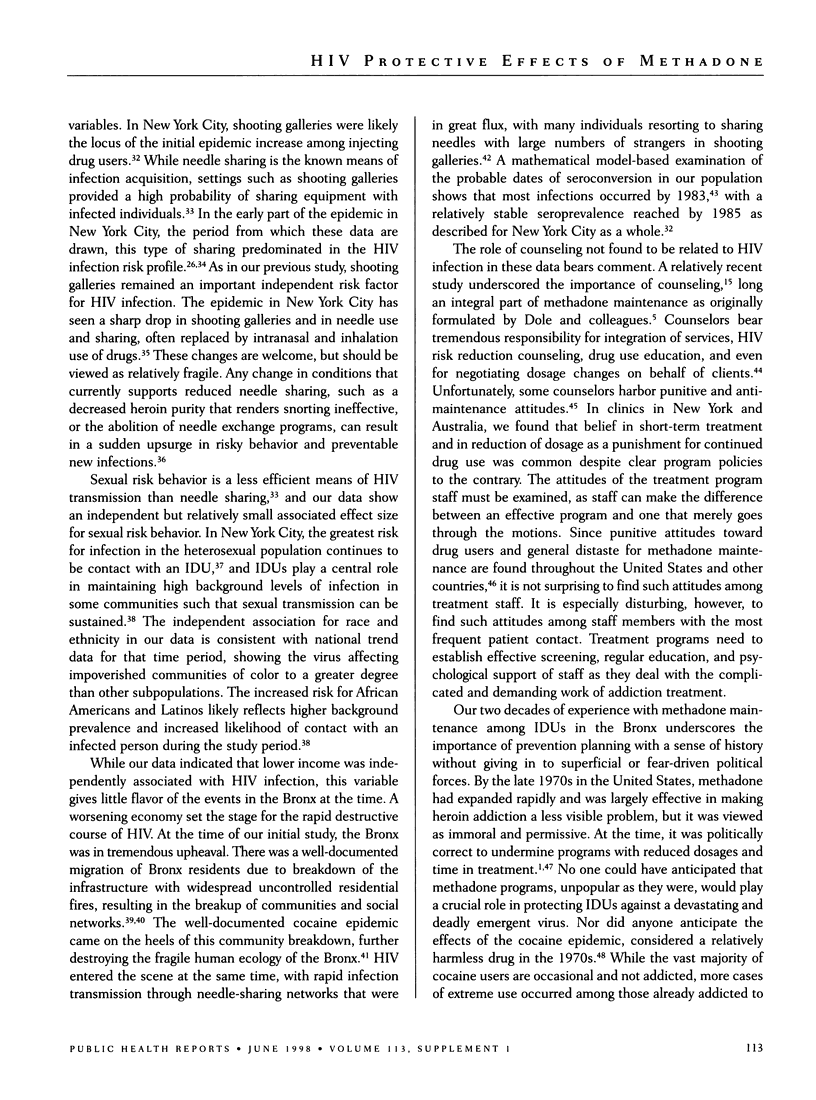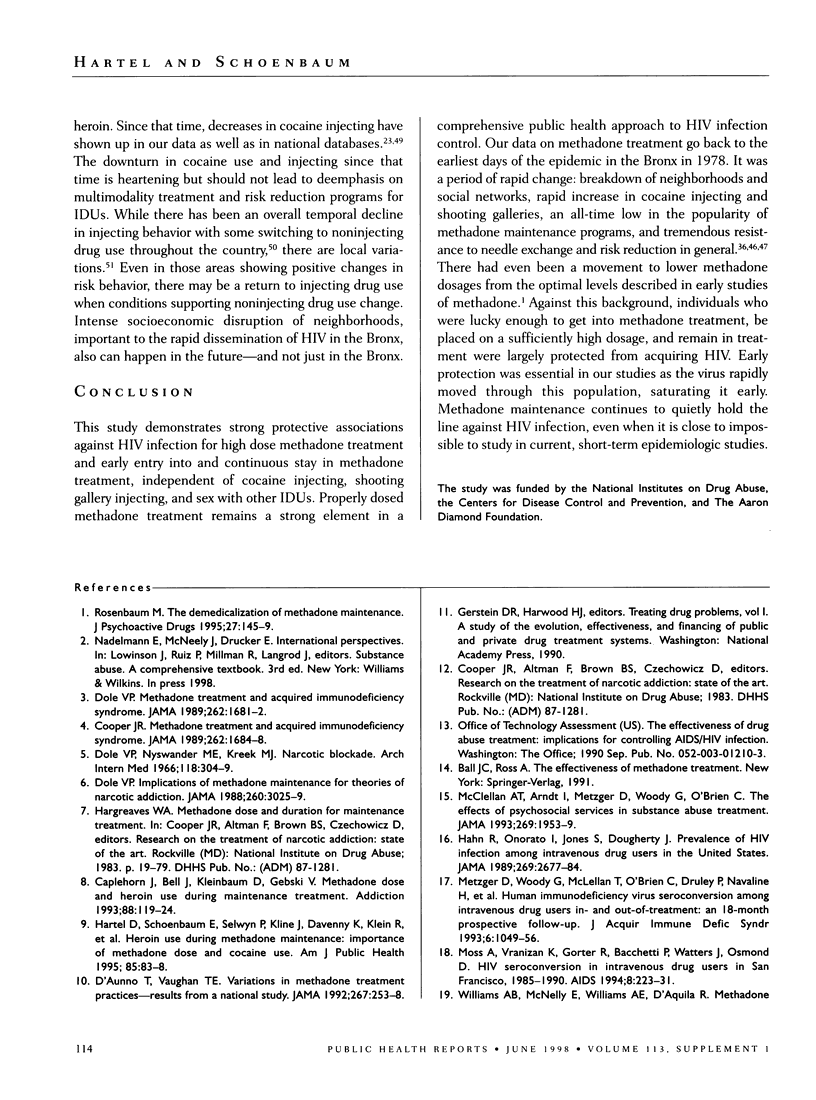Abstract
OBJECTIVE: We undertook a study of the role of methadone maintenance in protecting injecting drug users (IDUs) from human immunodeficiency virus (HIV) infection from the earliest days of the HIV epidemic in New York City to the present. The historical context of the epidemic in the Bronx is discussed. METHODS: For close to two decades, we have been tracking changes in injecting drug use and HIV infection levels in a Bronx cohort study of IDUs. An initial sample of 622 IDUs was recruited from a methadone treatment program in 1985, with historical data going back to 1978. Behavioral interviews and HIV testing were performed and methadone treatment program records (urine toxicology and methadone dose history) were reviewed. We examined both prevalent and incident HIV infections. The sample included African Americans (24.3%), Latinos (50.3%), and white non-Latinos (24.4%). The average methadone dose was 64 milligrams (mg) per day with an average time in treatment of five and a half years. RESULTS: We found a very low rate of incident infection of 1.7 per 100 person-years observation since 1986. Because of this low rate of infection, we were unable to determine the association between methadone treatment factors and HIV seroincidence. We found that our prevalence data on the 622 IDUs enrolled from 1985 to 1988 yielded strong findings on the role of methadone maintenance in a period when most infections occurred in this population. HIV seroprevalence was 42.9%. Logistic regression analysis revealed associations of methadone dose > or = 80 mg (adjusted odds ratio = 3.07/yr, 95% confidence interval (CI): 1.23-7.68) and last year entered methadone treatment (adjusted odds ratio = 1.22/yr, 95% CI: 1.06-1.41) to HIV infection, independent of year of last cocaine injection, needle sharing in shooting galleries, number of IDU sex partners, low income, and African American of Latino ethnicity. CONCLUSIONS: Properly dosed, long-term methadone treatment was found to be a central protective factor in preventing HIV infection from the earliest days of the epidemic in New York City. It is crucial to have high quality drug treatment programs in place before an epidemic draws our attention to the inadequacies through excess and unnecessary morbidity and mortality.
Full text
PDF








Selected References
These references are in PubMed. This may not be the complete list of references from this article.
- Alcabes P., Friedland G. Injection drug use and human immunodeficiency virus infection. Clin Infect Dis. 1995 Jun;20(6):1467–1479. doi: 10.1093/clinids/20.6.1467. [DOI] [PubMed] [Google Scholar]
- Anthony J. C., Vlahov D., Nelson K. E., Cohn S., Astemborski J., Solomon L. New evidence on intravenous cocaine use and the risk of infection with human immunodeficiency virus type 1. Am J Epidemiol. 1991 Nov 15;134(10):1175–1189. doi: 10.1093/oxfordjournals.aje.a116021. [DOI] [PubMed] [Google Scholar]
- Blower S. M., Hartel D., Dowlatabadi H., Anderson R. M., May R. M. Drugs, sex and HIV: a mathematical model for New York City. Philos Trans R Soc Lond B Biol Sci. 1991 Feb 28;331(1260):171–187. doi: 10.1098/rstb.1991.0006. [DOI] [PubMed] [Google Scholar]
- Blower S., Hartel D. HIV, drugs, and ecology. Science. 1989 Dec 8;246(4935):1236–1236. doi: 10.1126/science.2588002. [DOI] [PubMed] [Google Scholar]
- Caplehorn J. R., Hartel D. M., Irwig L. Measuring and comparing the attitudes and beliefs of staff working in New York methadone maintenance clinics. Subst Use Misuse. 1997 Mar;32(4):399–413. doi: 10.3109/10826089709039361. [DOI] [PubMed] [Google Scholar]
- Chaisson R. E., Bacchetti P., Osmond D., Brodie B., Sande M. A., Moss A. R. Cocaine use and HIV infection in intravenous drug users in San Francisco. JAMA. 1989 Jan 27;261(4):561–565. [PubMed] [Google Scholar]
- Condelli W. S., Fairbank J. A., Dennis M. L., Rachal J. V. Cocaine use by clients in methadone programs: significance, scope, and behavioral interventions. J Subst Abuse Treat. 1991;8(4):203–212. doi: 10.1016/0740-5472(91)90040-h. [DOI] [PubMed] [Google Scholar]
- D'Aunno T., Vaughn T. E. Variations in methadone treatment practices. Results from a national study. JAMA. 1992 Jan 8;267(2):253–258. [PubMed] [Google Scholar]
- Des Jarlais D. C., Friedman S. R., Novick D. M., Sotheran J. L., Thomas P., Yancovitz S. R., Mildvan D., Weber J., Kreek M. J., Maslansky R. HIV-1 infection among intravenous drug users in Manhattan, New York City, from 1977 through 1987. JAMA. 1989 Feb 17;261(7):1008–1012. doi: 10.1001/jama.261.7.1008. [DOI] [PubMed] [Google Scholar]
- Des Jarlais D. C., Friedman S. R., Sotheran J. L., Wenston J., Marmor M., Yancovitz S. R., Frank B., Beatrice S., Mildvan D. Continuity and change within an HIV epidemic. Injecting drug users in New York City, 1984 through 1992. JAMA. 1994 Jan 12;271(2):121–127. [PubMed] [Google Scholar]
- Des Jarlais D. C., Paone D., Friedman S. R., Peyser N., Newman R. G. Regulating controversial programs for unpopular people: methadone maintenance and syringe exchange programs. Am J Public Health. 1995 Nov;85(11):1577–1584. doi: 10.2105/ajph.85.11.1577. [DOI] [PMC free article] [PubMed] [Google Scholar]
- Diaz T., Chu S. Y., Byers R. H., Jr, Hersh B. S., Conti L., Rietmeijer C. A., Mokotoff E., Fann S. A., Boyd D., Iglesias L. The types of drugs used by HIV-infected injection drug users in a multistate surveillance project: implications for intervention. Am J Public Health. 1994 Dec;84(12):1971–1975. doi: 10.2105/ajph.84.12.1971. [DOI] [PMC free article] [PubMed] [Google Scholar]
- Dole V. P. Implications of methadone maintenance for theories of narcotic addiction. JAMA. 1988 Nov 25;260(20):3025–3029. [PubMed] [Google Scholar]
- Dole V. P. Methadone treatment and the acquired immunodeficiency syndrome epidemic. JAMA. 1989 Sep 22;262(12):1681–1682. [PubMed] [Google Scholar]
- Dole V. P., Nyswander M. E., Kreek M. J. Narcotic blockade. Arch Intern Med. 1966 Oct;118(4):304–309. [PubMed] [Google Scholar]
- Drucker E., Vermund S. H. Estimating population prevalence of human immunodeficiency virus infection in urban areas with high rates of intravenous drug use: a model of the Bronx in 1988. Am J Epidemiol. 1989 Jul;130(1):133–142. doi: 10.1093/oxfordjournals.aje.a115304. [DOI] [PubMed] [Google Scholar]
- Fordyce E. J., Blum S., Balanon A., Stoneburner R. L. A method for estimating HIV transmission rates among female sex partners of male intravenous drug users. Am J Epidemiol. 1991 Mar 15;133(6):590–598. doi: 10.1093/oxfordjournals.aje.a115931. [DOI] [PubMed] [Google Scholar]
- Hagman G. Methadone maintenance counseling. Definition, principles, components. J Subst Abuse Treat. 1994 Sep-Oct;11(5):405–413. doi: 10.1016/0740-5472(94)90093-0. [DOI] [PubMed] [Google Scholar]
- Hahn R. A., Onorato I. M., Jones T. S., Dougherty J. Prevalence of HIV infection among intravenous drug users in the United States. JAMA. 1989 May 12;261(18):2677–2684. [PubMed] [Google Scholar]
- Hartel D. M., Schoenbaum E. E., Selwyn P. A., Kline J., Davenny K., Klein R. S., Friedland G. H. Heroin use during methadone maintenance treatment: the importance of methadone dose and cocaine use. Am J Public Health. 1995 Jan;85(1):83–88. doi: 10.2105/ajph.85.1.83. [DOI] [PMC free article] [PubMed] [Google Scholar]
- Lurie P., Drucker E. An opportunity lost: HIV infections associated with lack of a national needle-exchange programme in the USA. Lancet. 1997 Mar 1;349(9052):604–608. doi: 10.1016/S0140-6736(96)05439-6. [DOI] [PubMed] [Google Scholar]
- Marmor M., Des Jarlais D. C., Cohen H., Friedman S. R., Beatrice S. T., Dubin N., el-Sadr W., Mildvan D., Yancovitz S., Mathur U. Risk factors for infection with human immunodeficiency virus among intravenous drug abusers in New York City. AIDS. 1987 May;1(1):39–44. [PubMed] [Google Scholar]
- McLellan A. T., Arndt I. O., Metzger D. S., Woody G. E., O'Brien C. P. The effects of psychosocial services in substance abuse treatment. JAMA. 1993 Apr 21;269(15):1953–1959. [PubMed] [Google Scholar]
- Meandzija B., O'Connor P. G., Fitzgerald B., Rounsaville B. J., Kosten T. R. HIV infection and cocaine use in methadone maintained and untreated intravenous drug users. Drug Alcohol Depend. 1994 Oct;36(2):109–113. doi: 10.1016/0376-8716(94)90092-2. [DOI] [PubMed] [Google Scholar]
- Metzger D. S., Woody G. E., McLellan A. T., O'Brien C. P., Druley P., Navaline H., DePhilippis D., Stolley P., Abrutyn E. Human immunodeficiency virus seroconversion among intravenous drug users in- and out-of-treatment: an 18-month prospective follow-up. J Acquir Immune Defic Syndr. 1993 Sep;6(9):1049–1056. [PubMed] [Google Scholar]
- Moss A. R., Vranizan K., Gorter R., Bacchetti P., Watters J., Osmond D. HIV seroconversion in intravenous drug users in San Francisco, 1985-1990. AIDS. 1994 Feb;8(2):223–231. doi: 10.1097/00002030-199402000-00010. [DOI] [PubMed] [Google Scholar]
- Rosenbaum M. The demedicalization of methadone maintenance. J Psychoactive Drugs. 1995 Apr-Jun;27(2):145–149. doi: 10.1080/02791072.1995.10471683. [DOI] [PubMed] [Google Scholar]
- Saxon A. J., Calsyn D. A., Jackson T. R. Longitudinal changes in injection behaviors in a cohort of injection drug users. Addiction. 1994 Feb;89(2):191–202. doi: 10.1111/j.1360-0443.1994.tb00878.x. [DOI] [PubMed] [Google Scholar]
- Schoenbaum E. E., Hartel D. M., Gourevitch M. N. Needle exchange use among a cohort of injecting drug users. AIDS. 1996 Dec;10(14):1729–1734. doi: 10.1097/00002030-199612000-00018. [DOI] [PubMed] [Google Scholar]
- Schoenbaum E. E., Hartel D., Selwyn P. A., Klein R. S., Davenny K., Rogers M., Feiner C., Friedland G. Risk factors for human immunodeficiency virus infection in intravenous drug users. N Engl J Med. 1989 Sep 28;321(13):874–879. doi: 10.1056/NEJM198909283211306. [DOI] [PubMed] [Google Scholar]
- Serpelloni G., Carrieri M. P., Rezza G., Morganti S., Gomma M., Binkin N. Methadone treatment as a determinant of HIV risk reduction among injecting drug users: a nested case-control study. AIDS Care. 1994;6(2):215–220. doi: 10.1080/09540129408258632. [DOI] [PubMed] [Google Scholar]
- Siddiqui N. S., Brown L. S., Jr, Meyer T. J., Gonzalez V. Decline in HIV-1 seroprevalence and low seroconversion rate among injecting drug users at a methadone maintenance program in New York City. J Psychoactive Drugs. 1993 Jul-Sep;25(3):245–250. doi: 10.1080/02791072.1993.10472275. [DOI] [PubMed] [Google Scholar]
- Wallace R. A synergism of plagues: "planned shrinkage," contagious housing destruction, and AIDS in the Bronx. Environ Res. 1988 Oct;47(1):1–33. doi: 10.1016/s0013-9351(88)80018-5. [DOI] [PubMed] [Google Scholar]
- Wallace R. Urban desertification, public health and public order: 'planned shrinkage', violent death, substance abuse and AIDS in the Bronx. Soc Sci Med. 1990;31(7):801–813. doi: 10.1016/0277-9536(90)90175-r. [DOI] [PubMed] [Google Scholar]
- Williams A. B., McNelly E. A., Williams A. E., D'Aquila R. T. Methadone maintenance treatment and HIV type 1 seroconversion among injecting drug users. AIDS Care. 1992;4(1):35–41. doi: 10.1080/09540129208251618. [DOI] [PubMed] [Google Scholar]


